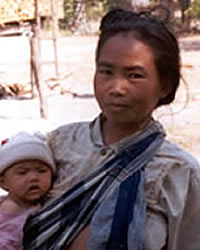Bru, Eastern in Vietnam

Photo Source:
Copyrighted © 2025
Peoples of Laos, Asia Harvest All rights reserved. Used with permission |
Send Joshua Project a map of this people group.
|
| People Name: | Bru, Eastern |
| Country: | Vietnam |
| 10/40 Window: | Yes |
| Population: | 70,000 |
| World Population: | 120,000 |
| Primary Language: | Bru, Eastern |
| Primary Religion: | Ethnic Religions |
| Christian Adherents: | 10.00 % |
| Evangelicals: | 7.07 % |
| Scripture: | Complete Bible |
| Ministry Resources: | Yes |
| Jesus Film: | Yes |
| Audio Recordings: | Yes |
| People Cluster: | Mon-Khmer |
| Affinity Bloc: | Southeast Asian Peoples |
| Progress Level: |
|
Introduction / History
The Eastern Bru of Vietnam live along the border Laos. They speak the same language as the Western Bru, but their dialects are distinct. Some of the Bru are bilingual, speaking both their native language and Lao or Vietnamese. The word "Bru" literally means "mountain." This name was probably given to the Bru in reference to their geographical location.
The Bru are descendants of the great Khmer Empire, which flourished between the ninth and thirteenth centuries. It encompassed present-day Thailand, Cambodia Laos and southern Vietnam. The Empire s power declined after being conquered by the Thai and Vietnamese. About 400 years ago, the Bru were pushed out of the best valley lands in northern Laos and forced southward by the Thai-speaking peoples.
What Are Their Lives Like?
Most of the Bru are wet-rice farmers. They have borrowed their agricultural techniques from the Lao, replacing their traditional "slash and burn" method with terrace irrigation. The fields are prepared with plows drawn by buffalo or oxen. Very few farmers have access to modern equipment. Many of the Bru who live in the mountainous regions or highlands continue to practice "slash and burn" farming. Some also hunt and fish to supplement their incomes. Others have become skilled merchants.
Bru villages are typically located along the banks of rivers or streams. The houses are usually arranged in a circle surrounding a central community house. Each home stands on stilts and is divided into several rooms to accommodate the extended family. The first room is used to receive guests. It also includes a sacred shrine for spirit worship.
The Bru live in small, self-governing villages that are often limited to a single valley. Each village is under the control of the chao muong, or prince, to whom the commoners pay taxes. The village headman, who is the eldest male, decides all important issues. Marriages are monogamous (one husband, one wife), and each family is under the leadership of the oldest male.
Bru folk art and literature are fairly well developed. They play a variety of musical instruments, accompanied by singing and narrative readings.
What Are Their Beliefs?
Virtually all of the Bru practice their own traditional religion. Ancestor worship (praying to deceased ancestors for prosperity, guidance and protection) is the most important activity. Each clan has a common worship place where they offer the dead uncooked rice, water and broken bowls. These ancestral spirits are thought to cause illnesses if they are not properly appeased. The Bru also believe in various spirits of nature and that each village has a particular "guardian spirit."
What Are Their Needs?
The area inhabited by the Bru contains landmines left behind by the Vietnam War. Deaths and injuries commonly occur when villagers are working in their fields or gardens. The wet rice farmers use traditional hoes to turn the soil. If a mine is struck with a hoe, it can explode, injuring or even killing those nearby. Many children have been seriously injured while playing in the fields as their parents worked.
The Bru need God's protection as they work in mine-laden fields. They need more education teams to teach them how to clear the mines. They also need medical assistance, especially with prostheses and physical therapy. These could be opportunities for Christian medical missionaries and humanitarian aid workers to gain access to these people.
Prayer Points
Pray for deliverance from the fear and deception that keeps the Bru from putting their faith in Christ.
Pray for God's blessing on the Bru leaders, their families and their communities.
Pray for the Lord to soften hearts and open ears to the gospel.
Ask the Lord to raise up strong local fellowships of believers that will plant more churches.